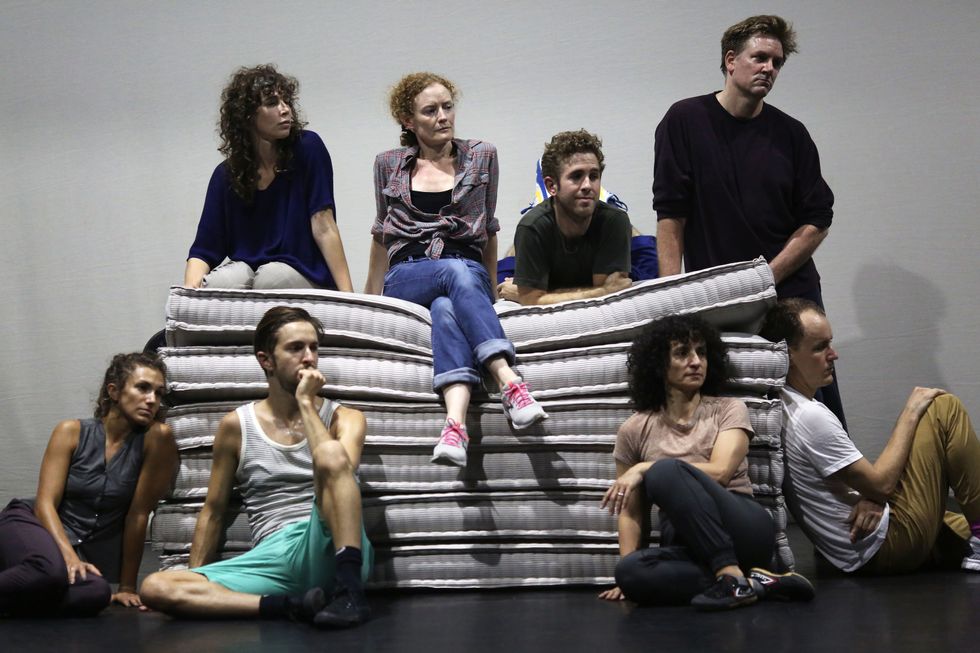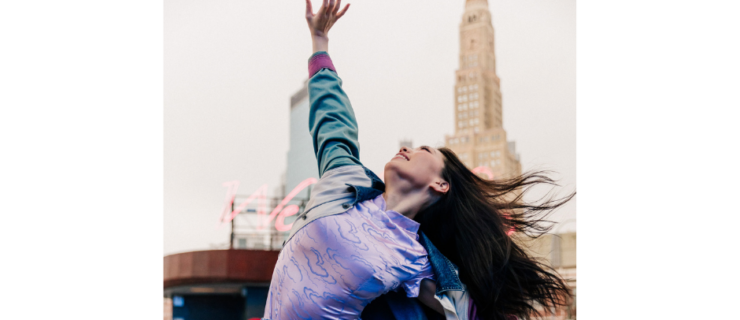Yvonne Rainer’s Mattress Dance That “Went Nowhere” Is Now Getting Somewhere
Yvonne Rainer’s Parts of Some Sextets (AKA “the mattress dance”) hasn’t been revived since it premiered in 1965. Nor has Rainer had any wish to do it again, to ask performers to heave 10 mattresses around while carrying out 31 tasks that changed every 30 seconds. It was an unwieldy, difficult dance. (Even the title is unwieldy.) But Emily Coates, who has danced in Rainer’s work for 20 years, became curious about this piece and was determined to see it again—and to dance in it. She will get her wish November 15–17, when the mattress dance will be performed as part of the Performa 19 Biennial.
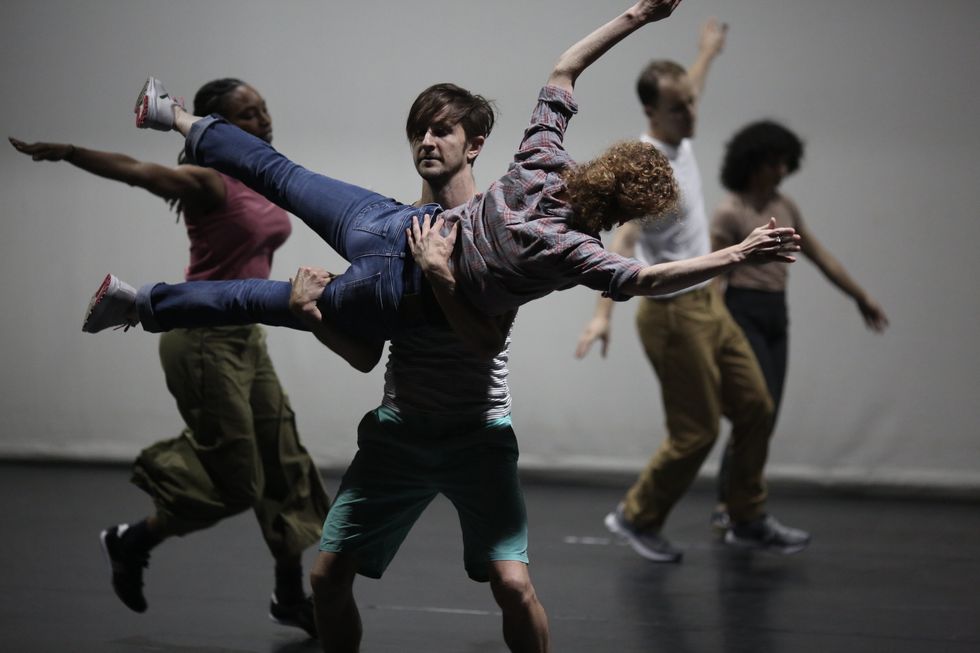
Paula Court, Courtesy Performa
Wendy:
Emily, why this piece? Yvonne had written that the dance “went nowhere…progressed as though on a treadmill or like a 10-ton truck on a hill.”
Emily:
It started with the photo at the “Robert Rauschenberg Among Friends” exhibition at MoMA in 2017. I had gone there with my husband Will and my daughter Eula, who was just 2. At the entry was a collage of photos, and there was the mattress dance—the iconic image of everyone stacked up on the mattresses. I said, “Look, Eula, this is Yvonne’s dance.” She knows Yvonne very well. I said, “Do you know which one is Yvonne?” And she pointed to her. That began it all—my daughter literally pointed me toward the mattress dance.
Yvonne to Emily:
What was your first approach to me? I don’t remember.
Emily:
I sent you an email, and you were reluctant.
Yvonne:
Wary. I was dragging my feet. Half of the score is missing.
Emily:
I was ready to fundraise for it, but then Performa said, “We’ll commission and produce this.”
Yvonne:
So you went out to the Getty Research Institute [which houses the Rainer archive] in California.
Emily:
The first morning I was there, you emailed me in capital letters: “AS I WAS GOING TO SLEEP LAST NIGHT IT HIT ME THAT THERE ARE THREE KEY ELEMENTS OF POSS THAT ARE ESSENTIAL TO ITS RECONSTRUCTION… I FERVENTLY HOPE THAT YOU WILL FIND THESE MATERIALS IN THE ARCHIVE —” And you listed the three main materials. I wrote back to reassure you I had found most of them.
Yvonne:
There were two sections of graph paper. And you didn’t find the other section.
Emily:
Right, we didn’t have the last third of the score. But Yvonne describes the end of the dance in her essay. We interpreted that description, and Yvonne has newly invented the rest.
Wendy:
Had you read Yvonne’s essay about this dance?
Emily:
Yes. I had begun to think about the mattress dance as a missing piece in the puzzle of Yvonne’s thinking. It preceded by one year the seminal work we all know, Trio A (1966), this four-minute, concise, theoretical blow-down of Western compositional aesthetics.
Wendy:
How did you work on the parts where there was no score?
Emily:
In different ways. Some of the 31 movements had to be reinvented. There’s a duet Yvonne did with Robert Morris. Yvonne and I tried to reconstruct it ourselves in the studio—with her partnering me! It was hilarious, and we quickly realized we needed another dancer. So Tim (Timothy Ward) joined us in the studio and together we reconstructed the duet choreography from the Peter Moore photos.
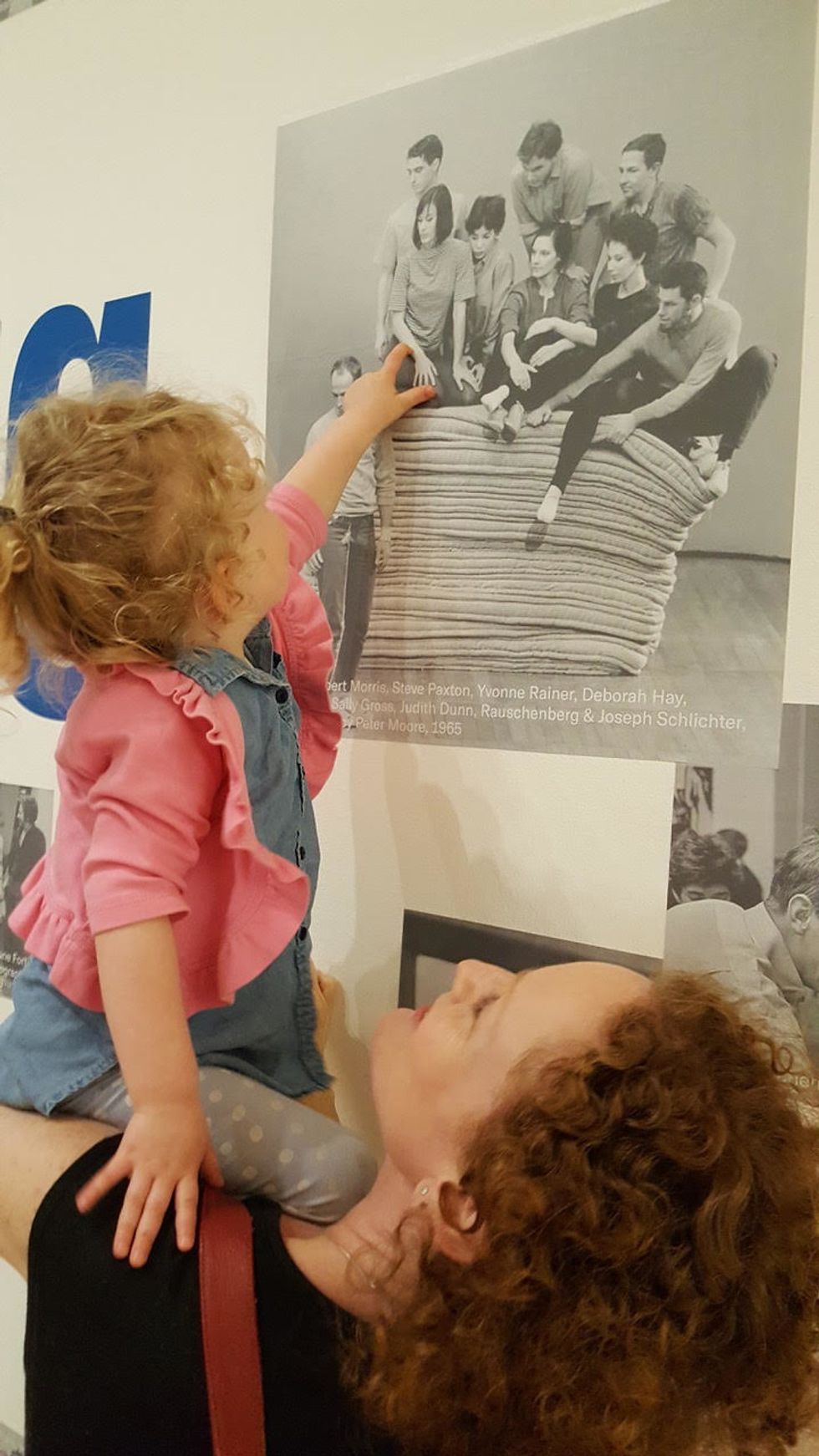
Will Orzo, Courtesy Coates
Wendy to Yvonne: You were in the original cast, so you didn’t get much of a chance to stand outside and look at it. What does it look like to you now?
Yvonne:
It looks kind of interesting. [Laughs.] I was aware back then, it was constantly metamorphosing and I found that interesting. What I didn’t realize was how may correspondences with the voiceover that there are.
Emily:
We hear them.
Wendy:
Did you use archival photos as evidence, beyond the famous ones?
Emily:
Yes, to an extent—thanks to Barbara Moore, Peter Moore’s widow, we had every image he had captured from the two locations (Wadsworth Atheneum and Judson Church) and found more photos at the Rauschenberg Foundation. There is a great photo of Steve Paxton slamming Rauschenberg into the mattresses—very forcefully but also Rauschenberg has a huge grin.
Wendy:
I want to ask you both about context. What was the cultural context in 1965, and what’s changed?
Yvonne:
The cultural context was minimalism. I was living with an artist [Robert Morris] who made sculpture along those lines and I was influenced. It also fit right in with the introduction of pedestrian movement in the early 60s. Also, everyone was reading Alain Robbe-Grillet’s For a New Novel, which was a critique of 19th-century romanticism and narrative conventions.
Emily:
There’s no character, no stories, no climax, only everyday quotidian description.
Yvonne:
No interiority of characters.
Emily:
The new version is part museum piece and part new work. Current viewers can’t fully experience what it must have been like to see the piece in ’65, but the 2019 version gives us a sense. It’s an epic work, with 12 dancers and 10 mattresses and complicated score that changed every 30 seconds—the ambition in it is astonishing. Its sheer scale stands out in the context of the other works created at Judson Dance Theater.
Yvonne:
Call it chutzpah.
Emily:
Truly—it’s a sprawling, 55-minute treatise on human civilization, expressed through the meticulous composition of daily tasks. For this current context, which feels like the political apocalypse, Yvonne has inserted new commentary.
Yvonne:
I eliminated a couple things and added a couple things from the Bentley.
Emily:
I’m talking about the current American political situation and how the work speaks to it.
Wendy:
Are there things in the current version that reference that?
Yvonne:
No, not at all.
Emily:
“F**king moron….deranged dips**t”?
Yvonne:
Oh, oh. I’m sorry. [laughing.] I forgot. It’s an intervention, with my voice on tape. That was not in the original piece.
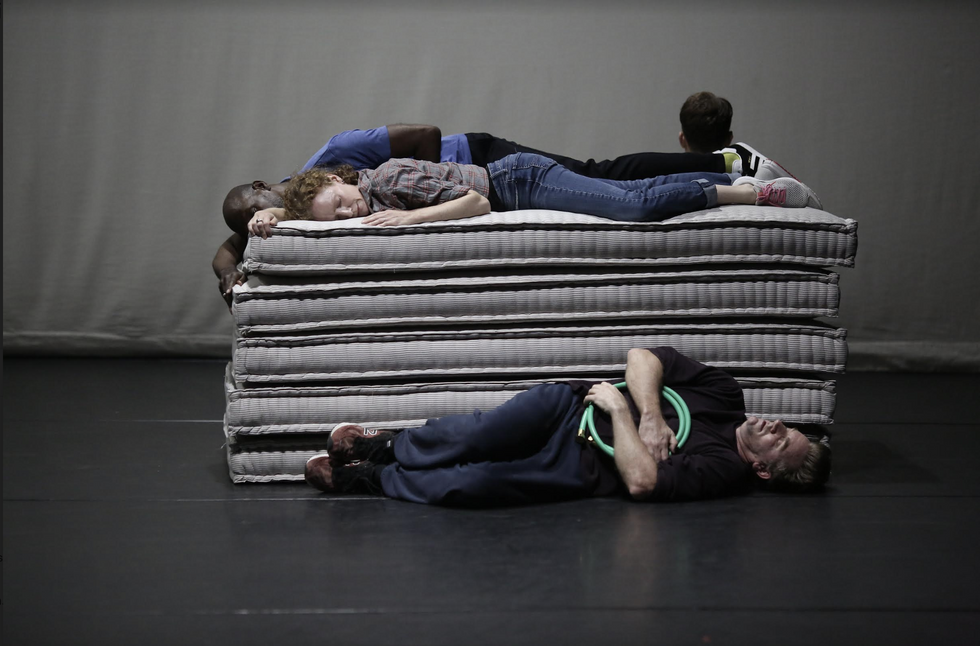
Paula Court, Courtesy Performa
Wendy:
I have to say, I had trouble with the Bentley reading. When I watched the rehearsal, I had to tune it out.
Yvonne:
Yeah, everyone deals with it differently. Some people go in and out. It’s hard to take both in at the same time.
Wendy:
What attracted you to this archaic diary?
Yvonne:
I read a review in The New York Times. There were about 30 volumes of this diary. Bentley had a long period in Salem as the minister. I went to the New York Public Library and started to read. I don’t think I articulated it in my essay at the time, but now it’s clear to me that the life of this village over this time is the perfect correlative to the life on the stage for 55 minutes with all these activities. Moving a mattress is fishermen coming in with their haul. Labor, relationships. Antagonisms.
Emily:
Life and death.
Wendy:
And suffering.
Yvonne:
Illness.
Wendy:
Deformity.
Yvonne:
I took a lot of the more morbid descriptions. A continuum of life and aging and birth and labor…. In the original cast, I didn’t have to persuade anyone. We were a community.
Wendy:
Emily, what’s the hardest part about performing this dance for you?
Emily:
It’s not getting lost in my score: the repetitions with variation can draw you into these eddies of reality in which you may suddenly realize you no longer know what’s next. But those repetitions are also a great pleasure to do in the dance. They feel literary: Things return in life, too, and each time they do you are different.
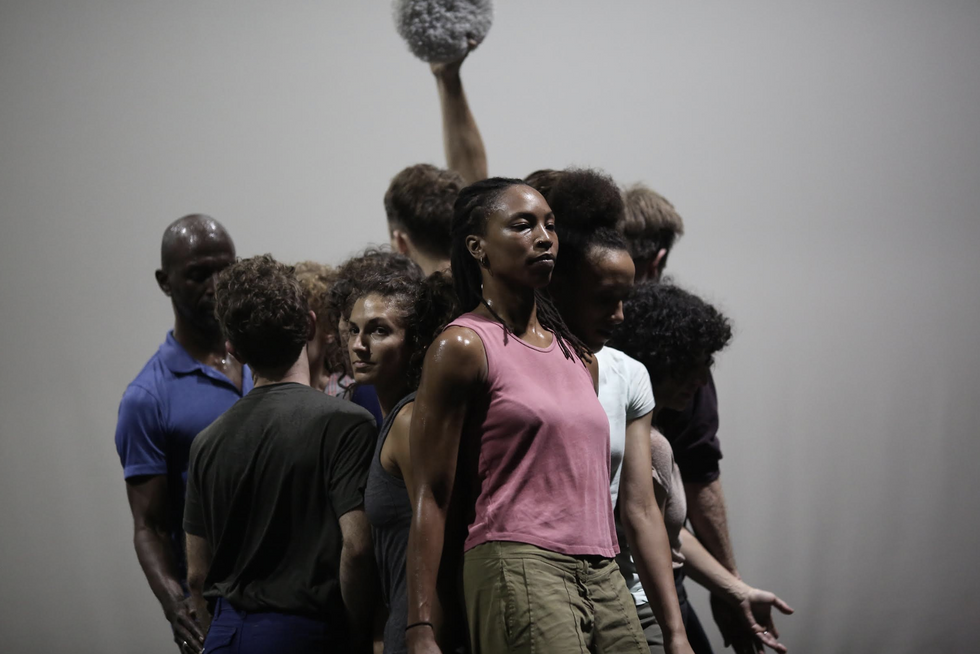
Paula Court, Courtesy Performa
Wendy to Yvonne:
Are there some aspects of this choreography that are common to other dances you’ve made?
Yvonne:
I find now that my ploys, I repeat myself. I love eccentric movement. Out of these very idiosyncratic gestures you have a group of people doing them in unison, so you have this combination of formality and eccentricity. That’s a formula and I use it to this day. Like they’re doing something in unison and all of a sudden someone breaks out—I don’t think you’ve ever seen this, it’s a new ploy—breaks out and runs around like a monster yelling, “RRHRHAHHHSAA” [growling fiercely]!
Emily:
Are you kidding? We did that in Spiraling Down [2008]!
Yvonne:
Oh okay, I forget. Okay, I’ve done it before. But here it was especially ferocious. I found someone who could really do that…. One of my favorite parts of the rehearsal process was when Tim goes under the mattress while Mary Kate is going the other direction on top, and he comes out of it all disheveled, in full view. I said, “Okay, just stand. Don’t make yourself presentable; just stand there and relax and we can see the whole effect from that.”
Emily to Yvonne:
Your creative energies are so undiminished! I don’t know how you have so much energy and attention to detail. Given the assignment, you are off and running.
Yvonne:
I can’t help myself.
